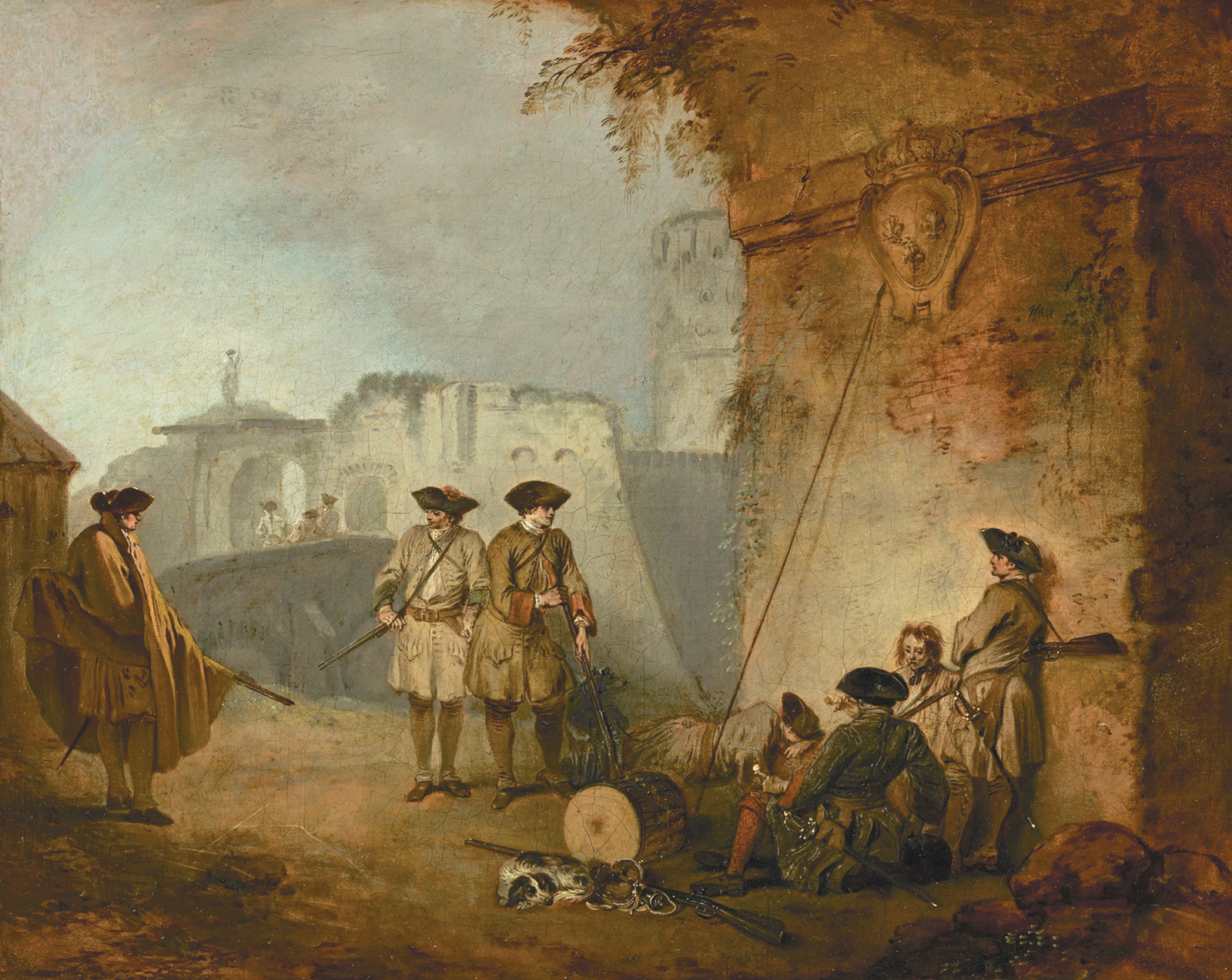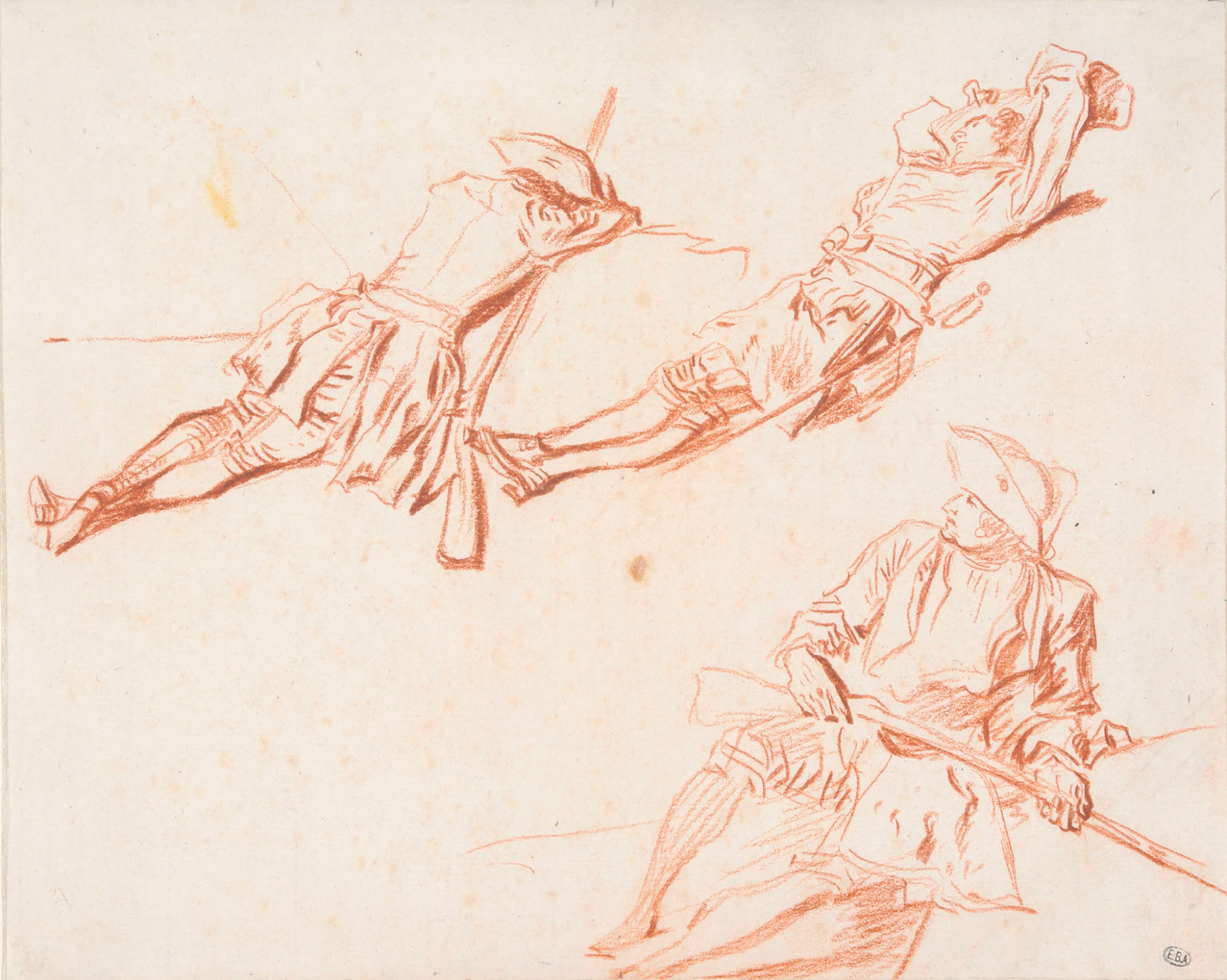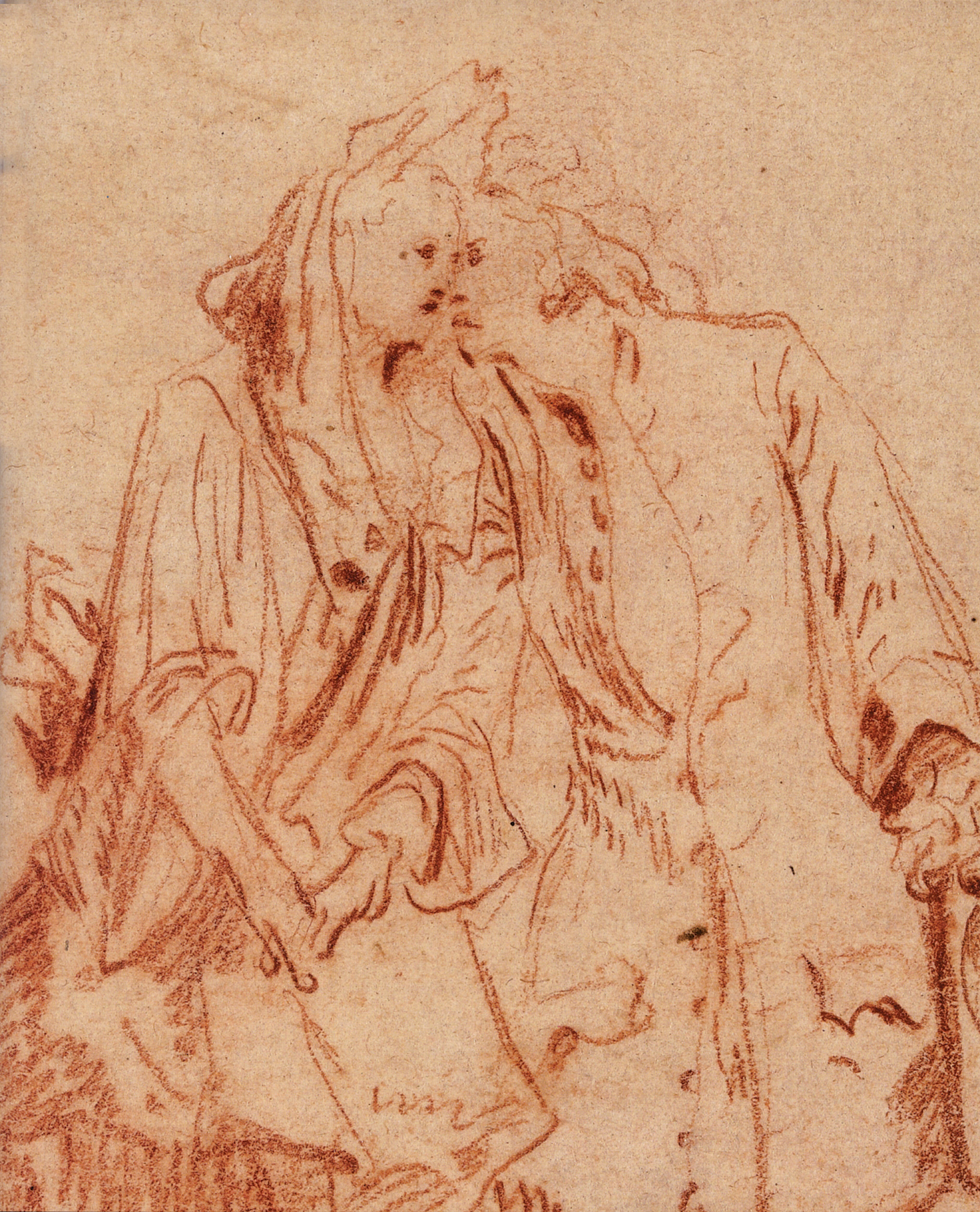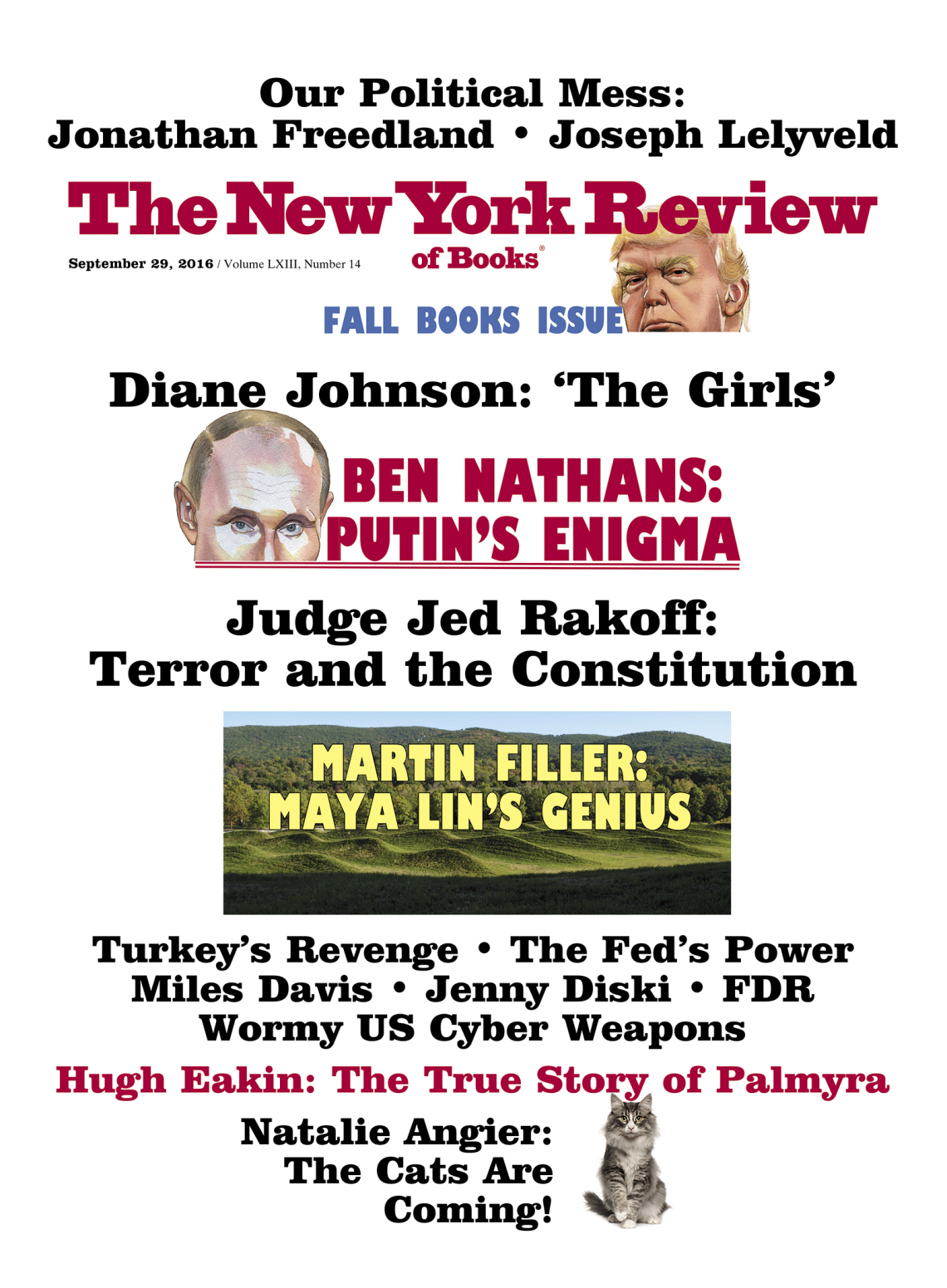There are painters who aim for a direct, blunt-force power. They marshal colors, shapes, figures, signs, and symbols to convey the strongest possible experiences and emotions. Caravaggio was that kind of painter. So was Rogier van der Weyden, at least when he painted a Crucifixion. In the work of these artists, a smile, a frown, a tear, a sword makes an immediate, unequivocal appeal. The painters are getting right to the point.
But for many of the greatest artists, getting right to the point is anything but the point. Antoine Watteau, who died in 1721 at the age of thirty-six, recoiled from painting’s graphic directness—from its blunt-force power. With Watteau, what you see in a painting, at least what you initially see, is appearances that mask as much as they reveal. The game has only begun. How could it be otherwise, when Watteau took such an interest in the vagaries of young adulthood and young love, themes that are nothing less than invitations to uncertainty?
Watteau was hardly alone in his recoil from visual lucidity. There are many artists who have launched a critique of clarity as they work to complicate painting’s emotional possibilities. To look for layers of feeling or sensibility in an art that is quite literally all on the surface is to almost immediately find oneself in the grip of a paradox. Piero della Francesca, Leonardo, Giorgione, Vermeer, Watteau, Chardin, Corot, Cézanne, Braque, and Giacometti have all, in their various ways, embraced this paradox. Beginning with the most fundamental spatial and narrative ambiguities, these artists mount ambiguity on ambiguity—not nihilistically, but constructively, in an effort to make painting subtle, sensuous, elusive. It was Braque who said that painting was like reading tea leaves. How do we read the tea leaves? That is among the most challenging questions raised by a beautiful exhibition at the Frick Collection—it occupies only a single room—entitled “Watteau’s Soldiers.”
Although Watteau was widely admired in his day and had friends who wrote about him after his death, we know relatively little of what he thought about art in general or his own art or the art of his contemporaries or his predecessors. We do know of his admiration for Rubens. And we are aware of his improvisatory compositional methods, which involved developing his paintings incrementally, with figures from his drawings incorporated into his paintings as he proceeded. But it remains impossible to say what Watteau thought about the artistic theories that flourished in Paris in the late seventeenth and early eighteenth centuries. His paintings of mostly young men and women gathered on terraces or in gardens in elegant clothes as well as costumes from the commedia dell’arte have inspired a torrent of commentary, but the commentators have not come close to a consensus.
As for “Watteau’s Soldiers,” an exhibition that focuses on a much less studied aspect of the artist’s work, once again there are many more questions than answers. Aaron Wile, a Ph.D. candidate at Harvard who has been a curatorial fellow at the Frick and organized the exhibition, is by no means the first and will surely not be the last to attempt to bring into focus what Watteau himself perhaps chose to leave out of focus. Watteau’s relatively few scenes of war and far more abundant studies of amorous experience pose interpretative problems that are not unrelated.
“Watteau’s Soldiers” is built around a painting, The Portal of Valenciennes (circa 1710–1711), that the Frick purchased in 1991. Here Watteau represents some half-a-dozen soldiers leisurely gathered next to an old stone structure, the ramparts of a fort or a city. To this painting, Wile has added three of the six other paintings on military subjects by Watteau that still exist, all of which represent not soldiers at war but soldiers in the preparations for or the aftermath of battle, whether eating or relaxing at an encampment or on the march. The paintings are all small, a foot or a foot-and-a-half high or wide. In addition to these compositions, the show includes thirteen of Watteau’s beautiful red-chalk drawings of soldiers, one of his very rare etchings, a number of prints after lost paintings and drawings, and a couple of works by other artists.
We know some of the background to this group of works in which we find Watteau’s young men at loose ends, enduring all the indecision, boredom, and confusion that come with prolonged periods of warfare. Watteau had been born in Valenciennes, in northern France, and when he returned in 1710, he encountered French soldiers who had retreated there after the Battle of Malplaquet, one of the most brutal of the War of the Spanish Succession, which lasted until 1714. In Valenciennes Watteau drew the soldiers and observed what their lives were like. In Paris there was a market for paintings of military subjects, so whatever Watteau’s inherent interest in the theme, dealers and collectors would have been encouraging him.
Advertisement
There were certainly precedents for showing warriors in the intervals between battles; Wile includes in “Watteau’s Soldiers” a small painting by the seventeenth-century Dutch painter Philips Wouwerman entitled The Cavalry Camp. But Watteau embraced the scruffiness and malaise of military life with an easygoing acceptance that might not have sat so comfortably with his Dutch predecessors. He brought to scenes of military life some of the down-and-dirty, anything-goes atmosphere that the Dutch had long cultivated in intimate studies of drinking and carousing. Although it is difficult to date Watteau’s military works, he seems to have continued to do them for four or five years.
Watteau’s drawings of soldiers have a startling kinetic power. I can’t think of another draftsman who knows how to give clothed figures such an urgent physicality. His studies of soldiers are electrically charged; the young men are always between states of vigor and exhaustion, attentiveness and repose. For Watteau clothing is not a covering but revealing, a second skin that accentuates and italicizes the body’s every twist and turn. In a beautiful pamphlet, Little Notes Concerning Watteau’s Portal of Valenciennes, which Edgar Munhall published in 1992, when he was curator of collections at the Frick, a great deal of attention is quite rightly lavished on the sartorial side of Watteau’s soldiers. They may be ordinary men, their flared coats, gaiters, and cockades nothing unusual, but these simple pieces of clothing become special when Watteau shows them fitted around slim, wiry bodies, often with the attractive angles of young limbs echoed by the angled form of a musket or a sword.
Watteau understands the sartorial privileges of youth, the elegance that young people can bring to the most modest clothing, even when they are dirty or tired. Among Watteau’s favorite images is the fully clothed figure seated or reclining on the ground. His exhausted soldiers—kneeling or resting on their stomachs or their backs with their hands above their heads—have an animal grace. However indifferent or disillusioned they may be, they still have the powerful presence of panthers relaxing after the kill.
It is easy to see how Watteau incorporated some of the figures in the drawings directly into his paintings, but in place of the purity of the drawings the paintings have a narrative complexity that to some may suggest a muddle. It is a muddle envisioned by a genius. What we are witnessing is the raw edges of war, not the battles but the marching and sleeping and eating and endless waiting. Watteau, who staged his amorous escapades along the leafy paths and in the secret corners of overgrown gardens, reveals the dark underside of his pastoral vision in these military scenes. Like the Greek and Roman poets, he recognized the bleakness that shadows any bucolic world. The ground is muddy, the skies are murky, and the trees are unhealthy.
There are tents, and Watteau seems to enjoy their unexpected shapes, especially one tent that has been created by draping lengths of cloth over the limbs of several big trees. There are horses, carts, pots and pans, and some crude, no doubt portable tables and benches. Soldiers drink, eat, smoke, talk, play cards. There are women (and sometimes women holding babies) in these paintings. They are servants, family members, hangers-on of one sort or another, and almost without exception seem even more ground down than the men, mostly without a hint of the erotic wit that Watteau elsewhere communicates with such easy brilliance.
Watteau’s military subjects are among the worst preserved of his paintings; the colors in many instances have drastically darkened. But even allowing for the inevitable depredations of time, his muted, equivocal color harmonies, which I am certainly not alone in believing were carefully calibrated to achieve a poetic ambiguity, can pose a challenge. The Supply Train (circa 1715)—probably the last of Watteau’s military scenes—might seem to some a compositional fiasco. I would prefer to describe it as unforgettably idiosyncratic. Scarcely more than a foot in any dimension, it is mostly smoky blues, greens, and whites, except for a soldier in his bright red coat, reclining on his back with his arms above his head in the foreground. In the very center of the composition two women with covered heads and dull-colored clothes, one older and one younger, kneel together, the younger one holding two children. There is a horse, a dog, a tent, an iron pot hanging over a fire, and a woman in more sophisticated clothing talking with another soldier, who reclines on his stomach, his head resting on one hand.
Advertisement
There is something visually cacophonous about all the variegated elements that Watteau has packed into this little composition. But this is a chaos that only a master could control—and Watteau does so by controlling it only lightly. The parts are perfectly observed. The soldier in his red coat is the piece of the puzzle that by refusing to fit in makes the whole scene come to life. He is the beautiful young man who remains somehow wonderfully oblivious to the ugliness of the world. At least that’s how he seems to us. He may be a fool. But it doesn’t matter. His sweet self-regard is to be treasured, whatever the circumstances.
What to make of Watteau’s paintings, whether scenes of love or war, is a question that raises fundamental problems in the interpretation of art. Beginning in the mid-nineteenth century, when the Goncourt brothers praised him for what they perceived as his melancholy lyricism, an extraordinary succession of literary figures, among them Verlaine, Walter Pater, and Samuel Beckett, have been drawn to what they see as Watteau’s ambiguous poetry. But Watteau said nothing about his work and little more light was shed on it by his admiring contemporaries.
It can be argued that we have invented a melancholy Watteau who would have been unrecognizable to the artist and his contemporaries. This, in an important book published in 1984, was the late Donald Posner’s view of the artist. “His pictures are robust and virile,” Posner wrote, “full of humor, sometimes bawdy in tone, and the action in them is not at all so vague or ambiguous as is usually thought.” There may be no way to refute many of the arguments that Posner put forth in his book. But that doesn’t mean that he is right. Pierre Rosenberg, who has studied Watteau more closely than many art historians, makes precisely the opposite case in the catalog of the great Watteau exhibition of 1984 at the National Gallery in Washington, arguing that “ambiguity…seems to be the primary characteristic of Watteau’s work, a quality that was deliberately chosen and knowingly nurtured by the artist.”
Aaron Wile, both in his long catalog essay for “Watteau’s Soldiers” and in a recent essay in The Art Bulletin, “Watteau, Reverie, and Selfhood,” wants to relate the unruly or ambiguous emotions that we perceive in the paintings to ideas and values current in Watteau’s own day. Like Posner, he locates Watteau firmly within the artistic culture of early-eighteenth-century Paris. And there can be no question that the Royal Academy, of which Watteau was ultimately a member although by some reckonings a halfhearted one, at least officially advocated a pictorial clarity that Watteau’s later admirers do not necessarily see in his work.
Watteau, Wile believes, knew exactly what he was doing when he rendered the inner lives of his soldiers inaccessible or impermeable. He wanted to capture the experience of interiority—the impossibility of knowing what’s in another person’s mind. This remoteness, Wile suggests, could have a philosophic basis in John Locke’s ideas about the inaccessibility to others of the individual’s consciousness, as described in his Essay Concerning Human Understanding—which was a subject of considerable interest in France in Watteau’s day, although of course we have no idea if Watteau read it or knew of it.
Wile seeks to bolster this argument for the interiority of Watteau’s soldiers by emphasizing the extent to which their enigmatic facial expressions diverge from the academic dogma of the time, with its insistence that in compositions in which figures were central, emotions of joy, sorrow, and so forth must be clearly legible. According to Wile, the hard-to-read expressions on Watteau’s soldiers’ faces reflect “the problem of the opacity of others’ inner lives,” much as the disorder of his compositions reflects “the essentially modern insight that society is held together by only the thinnest of threads.”
There is much that is attractive in Wile’s argument, but I worry that he presses too hard at certain points. By emphasizing the extent to which Watteau’s methods diverge from those of leading academic lights of the late seventeenth century, such as the history painter Charles Le Brun and the theorist Roger de Piles, he thrusts Watteau into an early-eighteenth-century academic-vs.-anti-academic dialogue or rivalry that may have been the farthest thing from his mind. I wonder if Watteau’s imagination wasn’t moving more afield as he developed his particular view of the soldier and the soldier’s life—for example to Jacques Callot’s seventeenth-century vision of soldiers who maintain an insular elegance even amid the maelstrom of war, or to sixteenth-century soldiers in paintings by Giorgione or the school of Giorgione who wear their arms and armor as if they were elements in some beguiling theatrical performance.
While there is a naturalistic grit about Watteau’s scenes of war that relates them to a Northern European tradition, there is also a dandified elegance about the soldiers in his drawings and in some of his paintings that is more Italianate in spirit, perhaps harking back, in ways impossible to trace, to the spirit of Castiglione’s Book of the Courtier. It might also be interesting to consider Watteau’s soldiers in relation to the famous prints after Michelangelo’s lost drawings for The Battle of Cascina, an influential sixteenth-century study of the bodies of male soldiers who have suddenly, in the midst of bathing, been called to battle and are hurriedly dressing. Of course Michelangelo’s massive figures are nothing like Watteau’s men, who are mostly thin. But these artists share an interest in the soldier who is for the time being not functioning as a soldier. The actor, removed from his appointed act, is now an object, his physicality presented as an occasion for contemplation.
Watteau was fascinated by the time in a person’s life when adolescence is a thing of the past and adulthood is not yet entirely a reality. Considering that it is young men more than any others who both go to war and fall in love, it isn’t so strange that Watteau, the great student of love’s enigmas, should have also been fascinated by the preparations for war. Much as he chose to focus not on love’s consummation but on the approach and the retreat—the foreplay, the flirtation, the memory—so his interest in war was not in war itself but in the buildup and the memory, the before and the after.
If Watteau avoided the hard fact of death in his war pictures, we must remember that in the largest and grandest of his studies of love, The Pilgrimage to the Island of Cythera (1717), it is the prologue or epilogue to love that we see, again not the thing itself. Scrub the grit and grime from Watteau’s soldiers and you find that they look very much like his lovers. And why not? Only the costumes have changed. Could it be that for Watteau the soldier putting on his handsome bright red coat wasn’t so different from the young man putting on the harlequin’s costume before going to the ball? One can object that Watteau has ignored the hard facts of war. But anybody who is looking for the hard facts ought to know to steer clear of Watteau.
This Issue
September 29, 2016
Maya Lin’s Genius
The Heights of Charm
How They Wrestled with the New





